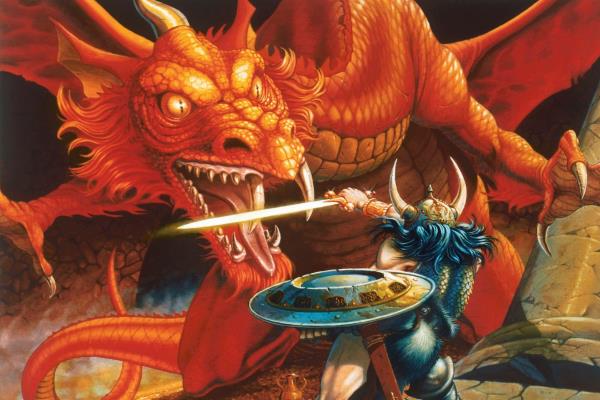Conflict management is a central element in Dungeons and Dragons (D&D), where players often find themselves in challenging and conflicting situations. As such, D&D easily lends itself as a place to learn how to deal with conflict in the real world. In this post, we explore how the conflict management lessons used in D&D can be applied to effectively cope with conflicts in business and beyond. We delve into the importance of active listening, collaborative problem-solving, fostering empathy, establishing common goals, and promoting win-win outcomes.
The featured image is a classic D&D (red box) painting by the talented Larry Elmore.
Active Listening: Understanding Perspectives
In D&D, conflicts arise due to differing character motivations, goals, and values. More often than not these bump up against those of perceived rivals. Active listening is crucial for understanding the perspectives of others. In turn, uncovering their underlying interests and concerns. Once understood conflict can often be defused or avoided altogether.
Similarly, in the business world, conflicts often stem from divergent viewpoints. By actively listening to all parties involved, professionals can gain insights, empathize with different perspectives, and facilitate meaningful dialogue for resolving conflicts.
In both cases, understanding the perspective of both parties often leads to de-escalation of potential conflict.
Collaborative Problem-Solving: Seeking Win-Win Solutions
I once had to spend a whole evening listening to a leader of a multi-national corporation argue that all negotiations were fights. Not only that, but there was always going to be a winner and a loser. Funnily enough he was fired a few weeks later. Proving my point that leaders who look for ways for all parties to win, build teams and alliances (and careers) that perform well into the future.
While playing the game, conflicts often require players to work together and find creative solutions that satisfy everyone’s objectives. Collaborative problem-solving focuses on finding win-win outcomes, where each party’s needs and interests are considered. While some players have a tendency to charge headlong into conflict with swords raised and fireballs soaring, I always find games where players look for innovative, collaborative solutions to be much more enjoyable.
This conflict management lesson shows that in the business world, fostering collaboration and encouraging stakeholders to seek mutually beneficial solutions helps build stronger relationships and leads to more sustainable resolutions. Instead of breeding distrust and antagonism, this approach fosters trust and collaboration.

Fostering Empathy: Building Connection and Understanding
Whilst playing D&D disagreements between players can arise, particularly when experiencing pressure or moral ambiguity as part of the adventure. These conflicts can be resolved by fostering empathy, where players try to understand each other’s character backgrounds, motivations, and emotions. Recognizing when another player is getting upset and then understanding why is key. Simply stopping play and checking in to see if there is a problem can prevent conflict from starting. If there is an issue, keeping an open and empathetic dialogue open to understand why is also key. Once that understanding is achieved diffusing the situation and moving back into the game can happen relatively smoothly.
Similarly, in the business world, empathy plays a vital role in conflict resolution. By putting themselves in others’ shoes and acknowledging different perspectives, professionals can build connections, establish trust, and find common ground for resolving conflicts. Likewise, conflicts arising within a team can be avoided by talking it through. Gaining an understanding of each others perspective can lead to insights for both parties and straight forward resolution.
If the conflict has already escalated the leader can step in as a neutral intermediary and help each side understand and empathize with each others position. As a third party bringing empathy into the conversation can have massive benefits.
Establishing Common Goals: Finding Shared Objectives
In D&D, conflicts can often arise from differing goals among the party members. Perhaps the elf wants to focus on uncovering arcane lore, whilst the warrior is more interested in building a stronghold and forming a kingdom. Players must find common ground and align their objectives to overcome these internal conflicts. Perhaps the stronghold can be built on an ancient site of ancient magical power. Suddenly their seemingly divergent goals converge and the source of conflict becomes a source of collaboration.
Likewise, in business, conflicts can also be resolved by identifying shared goals and focusing on the bigger picture. By emphasizing common objectives and shared interests, professionals can bridge gaps and create a collaborative environment for resolving conflicts. Often two parties actually want the same thing, but are approaching in different ways. Identifying this shared objective can diffuse conflict and create cohesion that would otherwise be prevented.
Negotiation and Compromise: Reaching Mutually Beneficial Agreements
D&D often requires negotiation and compromise to settle conflicts. Players must find middle ground and make concessions to reach agreements that benefit everyone involved. In recent iterations of the game players characters are almost invincible and as such take a combat first approach. I believe this actually misses a lot of the social nuances of the game. In older versions where characters were more vulnerable non combat negotiation was a sensible alternative. Why charge a group of mean looking bandits when you can negotiate a small fee to pass untouched. This doesn’t always work, as shown in my own home campaign.
In the business world, negotiation skills are essential for resolving conflicts. Professionals who understand the value of compromise, negotiate in good faith, and seek mutually beneficial outcomes can find resolutions that preserve relationships and promote long-term success.
I once worked with a CEO who saw negotiations as a fight. “There should always be a loser”, was his mantra. As such all performance reviews were seen as conflicts with him looking to “win”. Sales agreements with partner organizations were also treated this way. Two years later this sense of conflict escalated tot eh board and he was fired.
Looking for mutually beneficial outcomes is a much healthier way to approach business. It sets you and other up for success over the long term, together.

Learning from Conflict: Continuous Improvement and Growth
In D&D, conflicts provide opportunities for character growth, learning, and building stronger bonds within the party. Overcoming the evil Lich Lord and saving the kingdom through adversity forms stronger characters and better players beyond the mechanics of the game itself. The players will actually grow closer as a team. Heroes will become fully formed, beyond the scribbles on their character sheet. Not only that but the adventures create fond memories for years to come.
Similarly, in business, conflicts can be transformative. Professionals who approach conflicts as opportunities for learning and growth can identify areas for improvement, develop better communication skills, and foster a culture of continuous improvement within their organizations.
Final Thoughts on Conflict Management
Conflict management strategies in Dungeons and Dragons offer valuable lessons for managing conflicts in the business world. By practicing active listening, collaborative problem-solving, empathy, establishing common goals, and promoting win-win outcomes, professionals can navigate conflicts more effectively. In turn, these skills foster stronger relationships, improve communication, and create an environment where conflicts are seen as opportunities for growth and improvement. By applying the lessons learned from D&D, professionals can transform conflicts into catalysts for positive change, enhancing productivity, and promoting a harmonious and collaborative work environment.


An interesting read. It was fascinating to hear about corporate workers and CEOs you’ve worked with who see negotiations as having a winner and a loser. While I understand it may vary by industry, I believe, in general, adopting a mindset where everyone can win in a negotiation is healthier. This approach helps build long-term relationships, which could yield far more over time compared to engaging in a ‘fight’ mentality.
Thanks Josh. I’m with you on the win-win mindset. I found the whole negotiation as a battle argument really strange as well. Ultimately , I think that explains the particular individual falling out with the company owners and getting fired.
I like the way that critical failures can also be a great learning tool in team building. The party of adventurers learn how to do better next time without laying blame and creating conflict in a controlled environment..
That’s a great point Jake. Having scenarios based around critical failure would be an excellent learning tool.